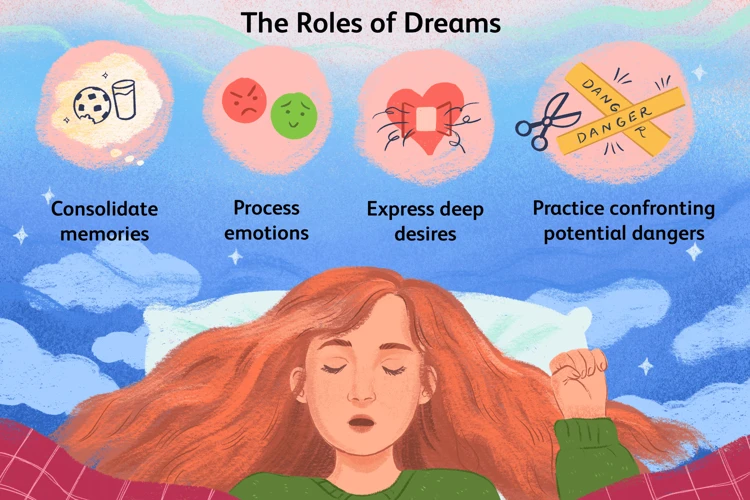As we drift off to sleep each night, our minds embark on a captivating journey filled with vivid images, strange scenarios, and powerful emotions. Dreams have always fascinated and perplexed us, serving as a gateway to a world beyond our conscious reality. But what is the connection between dreams and emotions? Are they mere reflections of our waking experiences or do they hold a deeper meaning? In this article, we will delve into the science of dreams and explore the role of emotions within them. We’ll uncover how emotions manifest in our dreams, the significance of deciphering their symbolism, and the profound impact they can have on our waking lives. So, fasten your seatbelts as we embark on a journey of self-discovery through the enigmatic realm of dreams and emotions.
The Science of Dreams

The study of dreams is a multi-faceted field, encompassing both psychological and neurological perspectives. Psychologically, dreams are seen as a window into our subconscious mind, revealing our deepest desires, fears, and unresolved conflicts. They provide invaluable insights into our thoughts and emotions, allowing us to explore aspects of ourselves that may be hidden during waking hours. Neurologically, dreams are a product of the intricate workings of the brain. When we sleep, different areas of our brain communicate and synchronize, creating a complex network of neural activity. This activity is thought to give rise to the vivid and often bizarre imagery we experience in our dreams. Additionally, during the REM (rapid eye movement) stage of sleep, the brainstem inhibits most voluntary muscle activity, effectively paralyzing our bodies to prevent us from physically acting out our dreams. Understanding the science behind dreams is crucial in unraveling the significance of the emotions that arise within them and exploring how dreams can be utilized for emotional healing. By unraveling the mysteries of the dream world, we can gain a deeper understanding of ourselves and our emotional landscape.
The Psychological Explanation
The psychological explanation of dreams delves into the intricate workings of the subconscious mind. According to renowned psychologist Sigmund Freud, dreams serve as a pathway to unlocking and understanding our deepest desires, fears, and repressed thoughts. Freud believed that dreams were symbolic representations of our unconscious wishes, often disguised in manifest content that may not directly relate to the underlying emotions. He introduced the concept of dream analysis, where the dreamer explores the hidden meanings behind the symbols and events in their dreams. Another prominent psychologist, Carl Jung, expanded on Freud’s theories and proposed that dreams also contain collective unconscious elements, representing universal symbols and archetypes that are shared across cultures and individuals. By analyzing dreams, we can gain valuable insights into our emotional states, working through unresolved issues, and even uncovering patterns of recurring emotions in dreams. Dream analysis provides a powerful tool for self-reflection and personal growth, allowing us to tap into the depths of our psyche and uncover the hidden messages within our dreams.
The Neurological Perspective
From a neurological perspective, understanding the connection between dreams and emotions involves examining the intricate workings of the brain during the dreaming process. When we enter the REM stage of sleep, the brain experiences increased activity, particularly in the limbic system which is responsible for regulating emotions. The amygdala, a key structure in the limbic system, plays a crucial role in the generation and processing of emotions. During REM sleep, the amygdala becomes highly active, leading to the experience of intense emotions within dreams. Additionally, the prefrontal cortex, responsible for logical thinking and decision-making, is less active during this stage, which may contribute to the often irrational and surreal nature of dream scenarios. Neurotransmitters like dopamine and serotonin also play a role in shaping dream experiences and influencing emotional content. Research shows that the brain processes dreams in a manner similar to how it processes waking experiences, with overlapping neural networks involved in memory consolidation and emotional processing. By exploring the neurological perspective of dreams, we gain insights into the complex mechanisms that underlie the interplay between dreams and emotions. This deeper understanding can facilitate emotional growth and provide opportunities for introspection and self-reflection.
The Role of Emotions in Dreams

Emotions play a profound role in the realm of dreams, both as content and triggers. In terms of content, dreams often evoke a wide range of emotions, including fear, joy, sadness, anger, and surprise. These emotions can be intensified or distorted in dreams, creating a heightened emotional experience. For example, a simple situation that may evoke mild annoyance during waking life can escalate into a furious rage in a dream. Similarly, a pleasant experience can turn into an overwhelming sense of euphoria. Exploring the emotional content of dreams can provide valuable insights into our emotional state and innermost desires. Emotions also serve as triggers for dreams. During sleep, our brains continue to process and organize our emotions, influencing the formation of dreams. If we experience intense or unresolved emotions during the day, they may find expression in our dreams. For instance, feelings of sadness or anxiety can manifest as nightmares or unsettling dreams, while positive emotions may result in pleasant and comforting dreams. By examining the role of emotions in dreams, we can begin to unravel the complex interplay between our inner emotional landscape and the fantastical world of dreams.
Emotions as Dream Content
play a significant role in shaping the landscape of our dreams. When we dream, our emotions can be intensified, exaggerated, and even completely transformed. Dreams have the power to evoke a wide range of emotions, from joy and excitement to fear and sadness. These emotional experiences become an integral part of the dream narrative, influencing the storyline and the overall atmosphere of the dream. For example, a dream filled with fear can manifest as a vivid nightmare, while a dream filled with happiness can transport us to a world of bliss. It is not uncommon for dreams to elicit multiple emotions simultaneously or rapidly shift between different emotional states. This emotional intensity can make dreams feel incredibly lifelike and leave a lasting impression upon waking. Understanding the emotions that arise within our dreams can provide valuable insights into our emotional state, unaddressed feelings, and unresolved conflicts in our waking life. By analyzing the emotions present in our dreams, we can gain a deeper understanding of ourselves and our emotional experiences as a whole.
Emotions as Dream Triggers
Emotions can serve as powerful triggers for the creation of dreams, influencing the content and experiences we have while asleep. When we experience intense emotions during the day, such as stress, anxiety, or excitement, these emotions can carry over into our dream world. Positive emotions like joy or love can manifest as pleasant dreams, while negative emotions like fear or anger can result in unsettling or even nightmarish dreams. The emotional intensity we feel during waking hours can impact the emotional intensity of our dreams. For example, if we encounter a stressful situation during the day, our dreams might reflect that stress through tense scenarios or feelings of unease. Similarly, if we experience a strong surge of happiness or accomplishment, our dreams may mirror those positive emotions. This connection between waking emotions and dream content highlights the intrinsic link between our emotional state and the world of dreams. By paying close attention to our emotions in daily life, we can gain insight into potential dream triggers and explore the recurring emotions that may be present in our dreams. These recurring emotions can provide valuable clues about underlying psychological themes and unresolved issues that may require attention and exploration.
Interpreting Emotions in Dreams

When it comes to interpreting emotions in dreams, it is essential to recognize that emotions play a significant role both as dream content and as dream triggers. Emotions can serve as valuable clues to gaining insight into our subconscious mind. Dreams often elicit a wide range of emotions, including joy, fear, anger, sadness, and anxiety. Common dream emotions, such as falling, being chased, or flying, can carry symbolic meanings that relate to our waking life experiences and unresolved psychological conflicts. For example, falling may represent a loss of control or fear of failure, while being chased might symbolize a sense of vulnerability or avoidance of confronting a problem. Additionally, emotions can act as powerful dream triggers. Intense emotions experienced during the day can influence the content and tone of our dreams. Stress, excitement, or even positive life events can manifest in our dreams as heightened emotional experiences. Understanding the relationship between our emotions and dream symbolism is crucial in deciphering the messages our dreams hold. By exploring the symbolism of emotions in dreams, we can gain valuable insights into our subconscious mind and use these interpretations to navigate our waking life with greater self-awareness.
Common Dream Emotions and Their Meanings
When it comes to common dream emotions and their meanings, the dream world is a vast and intricate landscape of feelings. Dreams have the ability to evoke a wide range of emotions, from joy and excitement to fear and sadness. Each emotion in a dream can hold a deeper significance and provide valuable insights into our subconscious mind. Let’s explore some of the most common dream emotions and their possible meanings:
1. Fear: This emotion is often experienced in dreams and can stem from various sources. It could represent unresolved anxieties or fears in our waking life that we need to address. It may also serve as a symbol of a need for self-protection or the anticipation of potential obstacles.
2. Joy: Experiencing joy in a dream can signify feelings of contentment and fulfillment. It may indicate that we are in a positive emotional state or that we have achieved a sense of accomplishment in our waking life.
3. Sadness: Sadness in dreams can reflect underlying feelings of loss, grief, or longing. It may be a manifestation of unresolved emotions that we need to acknowledge and process.
4. Anger: Dreams that evoke feelings of anger often symbolize repressed or unexpressed emotions. It may be a sign that we need to address conflicts or frustrations in our waking life.
5. Confusion: Feeling confused in a dream can indicate a lack of clarity or direction in our waking life. It may be a reminder to seek answers or make decisions about important aspects of our lives.
6. Surprise: Dreams that elicit surprise can signify unexpected events or changes that may be on the horizon. They may also represent a need for spontaneity and embracing new experiences.
7. Love: Dreams that evoke feelings of love can reflect our desires for emotional connection, intimacy, or fulfillment in our relationships. It may also symbolize self-love and acceptance.
It’s important to note that the interpretation of dream emotions is highly subjective and can vary from person to person. Understanding the specific emotions we experience in our dreams can provide valuable insights into our innermost thoughts, feelings, and desires. By paying attention to these emotions, we can begin to unravel the hidden messages and meanings behind our dreams.
Symbolism of Emotions in Dreams
When it comes to dreams, emotions often take center stage, serving as powerful guides to our innermost thoughts and feelings. In the realm of dreams, emotions are not always direct representations of our waking experiences; rather, they often manifest symbolically. The symbolism of emotions in dreams can be a complex and fascinating aspect to explore. For example, fear in a dream may not necessarily indicate the presence of danger in our waking lives but could instead represent feelings of insecurity or vulnerability. Similarly, experiencing joy in a dream might symbolize a deep sense of contentment or fulfillment. These symbolic representations of emotions in dreams can provide valuable insights into our subconscious mind. By analyzing the context, themes, and recurring patterns of emotions within our dreams, we can begin to unravel the hidden meanings they hold. It is important to approach these interpretations with an open mind and consider personal associations and experiences that may influence the symbolism of emotions in our dreams. By deciphering these emotional symbols, we can gain a deeper understanding of ourselves and the unconscious aspects of our being.
The Impact of Dreams on Emotions

Dreams have a profound impact on our emotions, both during sleep and upon waking. Emotional release in dreams is a common phenomenon, providing a cathartic outlet for pent-up emotions. Many individuals report experiencing intense emotions in their dreams, such as fear, joy, sadness, or anger. These emotions can be so vivid that they have a lasting effect even after waking up, lingering in our minds and influencing our mood and outlook. Dreaming allows us to process and explore complex emotions in a safe and controlled environment. It provides an opportunity for emotional release and a chance to confront unresolved issues or unresolved experiences. Additionally, dreams have the power to evoke emotional resonance upon waking. Certain dreams can leave us feeling elated, inspired, or unsettled long after we have opened our eyes. They have the ability to leave a lingering emotional imprint that can influence our thoughts, behavior, and perception of the world around us. By acknowledging and examining the impact of dreams on our emotions, we can gain a deeper understanding of ourselves and the emotional landscape that shapes our daily lives.
Emotional Release in Dreams
Emotional release in dreams is a phenomenon that occurs when we use dreams as a way to process and express our emotions. During sleep, our subconscious mind is free to explore and confront emotions that may be suppressed or unresolved in our waking lives. Dreams provide a safe space for us to experience and release these emotions without the constraints of reality. For example, if we are feeling anger or frustration in our waking life, we may have dreams where we express these emotions in intense and exaggerated ways, such as shouting or lashing out. This release of pent-up emotions can be cathartic, allowing us to experience a sense of relief and emotional release. It is believed that this emotional release in dreams serves as a mechanism for the mind to regulate and restore emotional balance. The process of emotional release in dreams can be highly individualized, with each person experiencing it in unique ways. Some individuals may have intense and vivid dream experiences, while others may have more subtle and symbolic representations of their emotions. It is important to pay attention to our dreams and the emotions they evoke, as they can provide valuable insights into our emotional well-being and help us gain a deeper understanding of ourselves.
Emotional Resonance upon Waking
Emotional resonance upon waking is a common phenomenon that many of us have experienced after a particularly intense or vivid dream. It refers to the lingering emotions that we carry with us upon waking up from a dream. These emotions can range from joy and happiness to fear, sadness, or anxiety. The intensity of these emotions can be so potent that they can often affect our mood and mindset for the rest of the day. This emotional carryover is believed to be a result of the brain’s inability to immediately switch off the emotional response triggered during the dream. As we wake up, the emotional residue from the dream lingers in our consciousness, causing us to feel a sense of resonance with the emotions experienced in the dream. It’s important to recognize that the emotions we feel upon waking are not always direct reflections of real-life events or situations. Dreams have a way of distorting reality, and the emotions they evoke may not necessarily be directly tied to our current waking life circumstances. Understanding and exploring the emotional resonance upon waking can give us valuable insights into our emotional state, helping us identify any unresolved issues or emotions that may need our attention.
Exploring Lucid Dreaming and Emotional Healing
Lucid dreaming, a phenomenon where the dreamer becomes aware that they are dreaming while still in the dream state, has garnered significant interest in recent years. Beyond the sheer awe and excitement of being able to control and manipulate the dream narrative, lucid dreaming has also been explored as a potential tool for emotional healing. When we become lucid in a dream, we have the opportunity to confront and work through our deepest fears, traumas, and unresolved emotions in a safe and controlled environment. By actively engaging with our emotions and consciously navigating the dream landscape, we can confront and process challenging emotions that may be holding us back in our waking lives. Some individuals have reported experiencing cathartic emotional release during lucid dreams, where they are able to let go of pent-up emotions and find a sense of liberation and healing. Lucid dreaming also allows for the exploration of different perspectives and scenarios, providing an opportunity for personal growth and emotional resilience. It is important to note that while lucid dreaming can be a powerful tool for emotional healing, it should be approached with caution and guidance, especially for individuals dealing with trauma or mental health issues. The potential for healing through lucid dreaming opens up a whole new realm of possibilities for individuals seeking to understand and work through their emotions on a profound level.
Lucid Dreaming as a Therapeutic Tool
Lucid dreaming is a fascinating phenomenon that occurs when the dreamer becomes aware that they are dreaming and can exert some level of control over the dream narrative. This unique state of consciousness has garnered interest as a therapeutic tool for emotional healing. In a lucid dream, individuals can consciously confront and work through their deepest fears, traumas, and emotional blocks. By recognizing that they are in a dream, they can actively engage with the dream content and even modify it to meet their needs. This can provide a safe and controlled environment for exploring and resolving emotional issues that may be difficult to address in waking life. For example, someone who struggles with social anxiety may choose to confront their fears by interacting with dream characters. The freedom and flexibility of lucid dreams allow for experimentation and desensitization, helping individuals build resilience and confidence in their waking life experiences. Lucid dreaming can also facilitate emotional processing and provide a sense of empowerment, as dreamers can consciously choose to confront and explore challenging emotions that arise within the dream. The therapeutic potential of lucid dreaming is an exciting area of research and has the potential to offer new avenues for emotional growth and healing.
Utilizing Dreamwork for Emotional Growth
Utilizing dreamwork for emotional growth is a powerful tool that can help individuals gain insight into their innermost emotions and experiences. One approach to dreamwork is keeping a dream journal, where individuals record their dreams upon waking. This practice allows for reflection and analysis of dream content over time, revealing patterns and themes that may be connected to specific emotions or experiences. By identifying recurring emotions or symbols in dreams, individuals can gain a deeper understanding of their emotional landscape and the underlying issues they may be grappling with. Another technique is engaging in dream interpretation, either through personal reflection or with the help of a therapist or dream expert. This involves exploring the symbolism and imagery in dreams to uncover their hidden meanings and associations. For example, a dream featuring water may symbolize emotions and the subconscious mind. By decoding these symbols and reflecting on their personal significance, individuals can gain valuable insights into their emotional experiences and work towards emotional growth and healing. Additionally, dreamwork can involve actively engaging with dreams through techniques such as lucid dreaming, where individuals become aware that they are dreaming and can consciously interact with the dream environment. This can provide an opportunity for individuals to explore and address their emotions within the dream state, creating a safe space for emotional processing and growth. Whether through journaling, interpretation, or lucid dreaming, utilizing dreamwork for emotional growth offers a unique and profound avenue for self-discovery and healing.
Conclusion
In conclusion, exploring the connection between dreams and emotions reveals a profound interplay between our subconscious mind and our emotional well-being. The science of dreams, both from a psychological and neurological perspective, sheds light on the complexities of these nocturnal experiences. Dreams serve as a portal to our deepest desires, fears, and unresolved conflicts, providing valuable insights into our inner world. The emotions we encounter in our dreams hold symbolic meanings that can be deciphered through careful interpretation. By understanding these symbols, we can navigate our dreamscape with greater clarity and harness the therapeutic potential of dreams for emotional growth. Whether it’s experiencing emotional release within dreams or experiencing emotional resonance upon waking, there is a profound impact that dreams have on our emotional state. Lucid dreaming, in particular, has emerged as a powerful tool for therapy and emotional healing. By attaining awareness within our dreams, we can actively engage with our emotions and explore avenues for healing and personal growth. Ultimately, embracing the intertwined nature of dreams and emotions allows us to tap into a deeper level of self-awareness and harness the transformative power that lies within our nocturnal adventures.
Frequently Asked Questions
1. Can dreams reveal hidden emotions?
Dreams have the ability to bring our hidden emotions to the surface. As we sleep, our subconscious mind takes the stage, allowing suppressed feelings and unresolved conflicts to emerge in the form of dream imagery and experiences.
2. Why do we sometimes forget our dreams?
Forgetting dreams is a common occurrence due to the way our memory functions during sleep. Dream memories are stored in the hippocampus, a region of the brain associated with memory formation. However, the transition from sleep to wakefulness can cause these memories to fade quickly, making it difficult to recall dreams upon awakening.
3. Do dreams have a purpose?
While the exact purpose of dreams is still debated among scientists, they are believed to serve various functions. Some theories suggest that dreams help process emotions, consolidate memories, problem-solve, and even practice certain scenarios, helping us navigate real-life situations.
4. Can we control our dreams?
Yes, it is possible to control dreams through a practice known as lucid dreaming. Lucid dreaming occurs when an individual becomes aware that they are dreaming while still within the dream itself. With practice, one can learn to manipulate and control the dream narrative, leading to exciting and immersive experiences.
5. Are nightmares linked to emotional distress?
Yes, nightmares often have ties to emotional distress. They can be manifestations of fears, anxieties, or traumatic experiences. Nightmares allow us to process and confront emotional difficulties in a safe, symbolic realm, potentially aiding in emotional healing and resolution.
6. Can dreams help us solve problems?
Dreams may offer unique perspectives and insights that can help with problem-solving. During sleep, the brain continues to work on unresolved issues, making connections and associations that may lead to new solutions or creative ideas upon waking.
7. What role do emotions play in dream interpretation?
Emotions are vital in dream interpretation as they often provide clues to the underlying meaning of the dream. Analyzing the emotions experienced within the dream can help unravel personal associations and help decode the symbolic messages that the dream is trying to convey.
8. Do recurring dreams have specific emotional significance?
Recurring dreams may have specific emotional significance as they highlight unresolved issues or persistent emotions that need attention. They often serve as indicators of what we need to address in our lives, urging us to confront and resolve these emotional patterns.
9. Can dreams influence our waking emotions?
Yes, dreams can have a noticeable impact on our waking emotions. As we experience intense emotions within dreams, they can carry over upon awakening, affecting our mood, mindset, and overall emotional state throughout the day.
10. Can dream analysis be beneficial for emotional well-being?
Absolutely, dream analysis can be highly beneficial for emotional well-being. Exploring dreams and their emotional content can offer profound insights into our inner world, aiding in self-reflection, self-awareness, and emotional growth.








